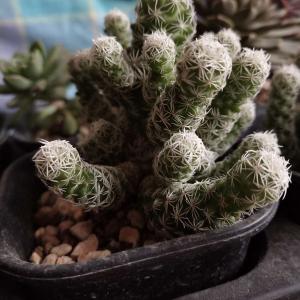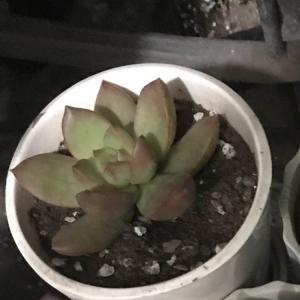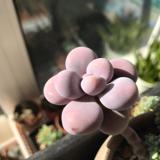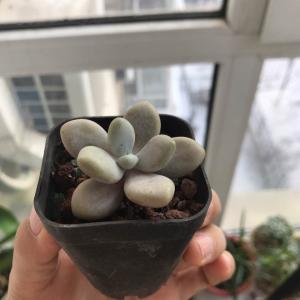文章
八公
2017年12月16日

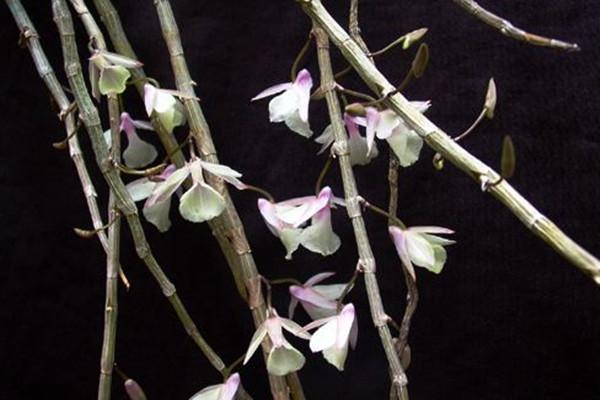
1.蜗牛
这种虫子主要是偷偷藏在叶子的背面,基本上都是靠着吃叶子或者是咬它的茎部来伤害花瓣。最让人头疼的是它一年内会发生很多次,一旦发生了,危害是特别大的,基本一个晚上就可以把整个植株给吃光了,所以一定要进行及时的防治。
防治方法:我们可以找来一些诱饵,在里面掺和一点毒药,放在它们经常出现的地方,就可以成功的把它们除掉了。或者也可以在栽培的土壤上面或者是周边的环境上喷洒上一些农药,也可以用一些生石灰和食盐水也是可以很好防治的。另外在平时最好注意一下栽培地方的卫生,像那些已经枯掉的叶子一定要及时的清理掉。
2.菲盾蚧
这种虫子一般都是寄生在它的植株叶片边上或者是叶子的背面,主要是来吸取植株的汁液生存,这样就会让整个植株的叶片开始干掉,严重的时候还会直接让植株死掉。同时还可能引发一些其他的病害。
防治方法:此害虫一般都是在5月的时候是它发育的高峰期,我们这时候可以混合使用一点农药进行喷洒,这样效果会比较好一点。如果是已经形成的虫子,而且量不多的话,可以把它的老枝叶给剪除掉,之后再集中在一起烧掉就可以了。
3.黑斑病
这种病害刚发生的时候,在叶子上面会出现很多黑褐色的斑点,慢慢发展,会发现叶子上的斑点附近会逐渐出现黄色,严重的时候黑斑就会相互形成片,最后就会掉落。
防治方法:这种病一般都是在夏天刚到的时候发生,那我们就需要在这个时候选择一些农药去喷洒防治,这样就可以很快的控制它的后续发展,防止它病变。
0
0
文章
Miss Chen
2017年12月16日


紫花凤梨体型不大,株高不及30厘米。叶窄线形,长20厘米-30厘米,宽1-1.5厘米,簇生,浓绿色,质硬面是凹弧状,中部带有紫褐色斑晕背绿褐色。花序梗自叶丛中抽生,长约20厘米,顶端12-15厘米处扁平,形成穗状花序,宽4-4.5厘米,由粉红色近淡紫色的苞片对生组;青紫色小花由苞片内开出,约20朵之多,花瓣卵形,3片;冠径约3厘米,形似蝴蝶。苞片可观赏达数月之久。

紫花凤梨是否有毒?
放在卧室内的植物我们首先会问的是植物是否有毒,其毒主要是所散发的气体,其实紫花凤梨在这方面并没有毒,反倒是可以吸收有害气体。但是植物本身有无毒,还没有明确的研究,养花的友友们也不会想去咬一口试试其植物本身有无毒吧,所以在不伤害植物的情况下,可以放心养殖。
能否放在卧室养殖?
可以放在卧室养殖,但卧室的空间若较小的,就不建议放进去了,除了紫花凤梨,其它植物也不建议摆放,可以白天移至卧室摆放,夜间移至客厅摆放。
从养殖紫花凤梨的角度来说,紫花凤梨需要良好的通风环境,而夜间的卧室相对来说通风环境较差,这很容易造成紫花凤梨的徒长,使它的花穗渐渐缩短,叶形也会变得较窄较长,花朵也会失去以往的光鲜亮丽,最主要的是特别容易引发病虫害,尤其是夏季,最为严重;放在卧室还需要注意的是光照,光照适合的情况下,花朵会变大,其颜色会更加鲜艳,外形也会越来越紧凑,但是要避开午间前后的阳光。
对于紫花凤梨可以放卧室这个问题就解说到这里,友友们可以根据自己的实际情况来决定要不要放在卧室内养殖。
0
0
文章
Miss Chen
2017年12月16日

Description: This wildflower consists of a low rosette of basal leaves up to 6" across; a mature plant will produce one or more flowering stalks about ½–1' tall. The blades of the basal leaves are up to 3" long and 2½" across; they have stout hairy petioles up to 1½" long. The basal leaves are more or less oval in shape, crenate along their margins, palmately veined, and hairy on both their upper and lower surfaces; the upper surface of each leaf is medium green, while the lower surface is pale green or pale purplish green. Each flowering stalk is stout, erect, terete, light green, and very hairy; it has small alternate leaves up to 1¼" long and ½" across, which become gradually smaller as they ascend toward the inflorescence. The alternate leaves are similar to the basal leaves, except they are ovate in shape and smaller in size. Each alternate leaf is sessile or it clasps the stalk.
The inflorescence consists of a stout spike of small flowers about 2-6" long. These flowers are densely clustered along the spike, facing in all directions. Underneath each flower, there is a small leafy bract that is lanceolate. Each flower has a 2-lipped corolla that is cream-colored or pale yellow, and a calyx consisting of 4 green sepals that are elliptic and hairy. The corolla is about 5 mm. long and slightly longer than the calyx; the upper lip of the corolla is unlobed, while the irregular lower lip is unlobed or divided into 2-3 lobes. Each flower has a pair of exserted stamens and a slender white style. The blooming period occurs from mid-spring to early summer, lasting about 3 weeks for a colony of plants. The flowers bloom gradually from the bottom of the spike to its apex. Afterwards, the flowers are replaced by small 2-celled seed capsules; each capsule contains several seeds. The root system consists of a cluster of coarse fibrous roots; an older plant may form a small caudex. This wildflower occasionally forms colonies at favorable sites.

Cultivation: The preference is full sun, dry conditions, and a barren acidic soil that is sandy or gravelly. Partial sun is also acceptable. This wildflower grows slowly and doesn't tolerate competition from taller, more aggressive plants. It is adaptable to sunny rock gardens and there are few problems with pests and disease.
Range & Habitat: The native Kittentails is restricted to the west-central and northwest sections of Illinois, where it is rare (see Distribution Map). This wildflower is state-listed as 'threatened.' Habitats include dry sand prairies, dry gravel prairies, hill prairies, barren savannas, thinly wooded bluffs, and sandy or gravelly riverbanks. This species is restricted to high quality habitats in natural areas; it is endemic to the Midwest and uncommon throughout its range.

Faunal Associations: The flowers are cross-pollinated by small bees, especially Halictid bees that seek nectar and/or pollen. The following Halictid bees have been observed to visit the flowers of Kittentails: Auglochlorella striata, Lasioglossum anomalum, and Lasioglossum vierecki (McKone et al., 1995; Moure & Hurd, 1987). Additional information about floral-faunal relationships is unavailable.
Photographic Location: The wildflower garden of the webmaster in Urbana, Illinois.
Comments: While not particularly showy, Kittentails is an unusual little plant. It resembles some broad-leaved Plantago spp. (Plantains), but the floral spike of Kittentails is more stout and its flowers are insect-pollinated. The closest relatives (either Besseya spp. or Synthyris spp.) are found in mountainous areas of the western states. These latter species usually have flowers (or floral bracts) that are purple, otherwise they are similar in appearance to their eastern counterpart. Another scientific name of Kittentails is Wulfenia bullii.
The inflorescence consists of a stout spike of small flowers about 2-6" long. These flowers are densely clustered along the spike, facing in all directions. Underneath each flower, there is a small leafy bract that is lanceolate. Each flower has a 2-lipped corolla that is cream-colored or pale yellow, and a calyx consisting of 4 green sepals that are elliptic and hairy. The corolla is about 5 mm. long and slightly longer than the calyx; the upper lip of the corolla is unlobed, while the irregular lower lip is unlobed or divided into 2-3 lobes. Each flower has a pair of exserted stamens and a slender white style. The blooming period occurs from mid-spring to early summer, lasting about 3 weeks for a colony of plants. The flowers bloom gradually from the bottom of the spike to its apex. Afterwards, the flowers are replaced by small 2-celled seed capsules; each capsule contains several seeds. The root system consists of a cluster of coarse fibrous roots; an older plant may form a small caudex. This wildflower occasionally forms colonies at favorable sites.

Cultivation: The preference is full sun, dry conditions, and a barren acidic soil that is sandy or gravelly. Partial sun is also acceptable. This wildflower grows slowly and doesn't tolerate competition from taller, more aggressive plants. It is adaptable to sunny rock gardens and there are few problems with pests and disease.
Range & Habitat: The native Kittentails is restricted to the west-central and northwest sections of Illinois, where it is rare (see Distribution Map). This wildflower is state-listed as 'threatened.' Habitats include dry sand prairies, dry gravel prairies, hill prairies, barren savannas, thinly wooded bluffs, and sandy or gravelly riverbanks. This species is restricted to high quality habitats in natural areas; it is endemic to the Midwest and uncommon throughout its range.

Faunal Associations: The flowers are cross-pollinated by small bees, especially Halictid bees that seek nectar and/or pollen. The following Halictid bees have been observed to visit the flowers of Kittentails: Auglochlorella striata, Lasioglossum anomalum, and Lasioglossum vierecki (McKone et al., 1995; Moure & Hurd, 1987). Additional information about floral-faunal relationships is unavailable.
Photographic Location: The wildflower garden of the webmaster in Urbana, Illinois.
Comments: While not particularly showy, Kittentails is an unusual little plant. It resembles some broad-leaved Plantago spp. (Plantains), but the floral spike of Kittentails is more stout and its flowers are insect-pollinated. The closest relatives (either Besseya spp. or Synthyris spp.) are found in mountainous areas of the western states. These latter species usually have flowers (or floral bracts) that are purple, otherwise they are similar in appearance to their eastern counterpart. Another scientific name of Kittentails is Wulfenia bullii.
0
0
文章
Miss Chen
2017年12月16日

Description: This perennial plant is up to 1½' tall and 3' across. One or more stems originate from the root system of each plant; these stems branch occasionally and they are ascending to widely spreading. The stems are light green to light purple and terete; for var. bracteata they are either pubescent or hairy, while for var. glabrescens they are glabrous. Alternate trifoliate leaves occur at intervals along these stems. Individual leaflets are 1–3" long and ½–1" across; they are usually oblanceolate in shape, but sometimes they are broadly elliptic or rhombic-elliptic. Leaf margins are smooth (entire). The leaf surfaces are grayish green; for var. bracteata they are appressed-hairy, while for var. glabrescens they are glabrous (Mohlenbrock, 2002). Leaf venation is pinnate. The trifoliate leaves are usually sessile or nearly so; less often, they have pedicels up to 1½" long. At the base of each trifoliate leaf (or its pedicel), there is a pair of leafy stipules; sometimes these stipules are early-deciduous and absent. These stipules can be highly variable in size (less than ¼" to 1½" long); they are sessile and usually lanceolate in shape with smooth margins. Like the leaflets, the stipules are grayish green and appressed hairy to glabrous, depending on the variety. The upper and outer stems of this plant often terminate in racemes of flowers about 3-9" long. These racemes are widely spreading and they are either held above the ground or they sprawl across it. The pedicellate flowers of these racemes face upward toward the light.

Individual flowers are about 1" long and a little less across; they have a typical pea-like floral structure consisting of an upright banner (1 petal) and a pair of wings (2 petals) that enclose the keel (2 petals). These petals are white to pale yellow (more or less cream-colored) and hairless. In addition to a corolla consisting of 5 petals, each flower has a short-tubular calyx with 4-5 triangular teeth, 10 stamens, and a pistil with a single style. The calyx is light green to light purple and less than ½" long; depending on the variety of this plant, it is either appressed-hairy or glabrous. The pedicels of the flowers are about ¾–1½" long, light green to light purple, and either hairy or glabrous. At the bases of these pedicels, there occurs solitary floral bracts that are about ½–1" long, lanceolate in shape, smooth along their margins, and sessile; they are similar to the stipules. The blooming period occurs during mid- to late spring for about 3 weeks. Afterwards, fertile flowers are replaced by seedpods that are 1-2" long, short-oblongoid in shape, slightly flattened, and mostly hollow inside. These seedpods have conspicuous beaks at their tips. Immature seedpods are light green and short-pubescent to glabrous; they become black at maturity. Later in the year, an entire plant may break off at its base, and roll around in the wind as a means of dispersing its seeds. Each seedpod divides into 2 parts to release its seeds; typically there are 5-20 seeds per seedpod. Individual seeds are about 4 mm. long, light brown to black, reniform (kidney-shaped), and glabrous. The root system consists of a stout taproot.
Cultivation: The preference is full sun, mesic to dry conditions, and soil containing some sand or loam. Cream Wild Indigo prefers open areas where there is reduced competition from taller vegetation. While it is possible to cultivate this plant in the garden using seeds or transplants, it develops slowly as most vegetative growth occurs during the cool weather of spring after the danger of hard frost has passed. Mature plants can be difficult to transplant because of their deep taproots.
Range & Habitat: The native Cream Wild Indigo occurs in scattered locations throughout Illinois (see Distribution Map), but it is uncommon, except at high quality sites. The typical variety, Baptisia bracteata bracteata, is more common in Illinois than Baptisia bracteata glabrescens. Natural habitats include mesic to dry black soil prairies, sand prairies, cemetery prairies, railroad prairies, open rocky woodlands, and sandy savannas. Occasional wildfires are beneficial in maintaining populations of this plant.

Faunal Associations: This plant is cross-pollinated primarily by queen bumblebees after they emerge from hibernation during the spring. Worker bumblebees appear somewhat later. Other long-tongued bees that have been observed to visit the flowers include a digger bee (Synhalonia speciosa) and mason bee (Osmia bucephala bucephala). These insects usually seek nectar from the flowers, although they sometimes collect pollen (Robertson, 1929). Other insects feed on the leaves, seeds, and other parts of Cream Wild Indigo and other Baptisia spp. These species include the larvae of such skippers as the Wild Indigo Duskywing (Erynnis baptisiae) and Hoary Edge (Achalarus lyciades), the larvae of such moths as the Three-lined Grapholita (Grapholita tristrigana) and Black-spotted Prominent (Dasylophia anguina), and the larvae of such butterflies as the Frosted Elfin (Callophrys irus), Orange Sulphur (Colias eurytheme), and Marine Blue (Leptotes marina); see Bouseman et al. (2006), Miller (1987), Wagner (2005), and Bouseman & Sternburg (2001). Another insect feeder is the Wild Indigo Weevil (Apion rostrum); the adults feed destructively on the flowers and leaves, while the larvae feed on the seeds (Sauer, 2005). Other insects that use Cream Wild Indigo and other Baptisia spp. as host plants include a leaf beetle (Pachybrachis luridus), seed-eating broad-headed bugs (Alydus spp.), oligophagous thrips (Neohydatothrips baptisiae), Keeler's Grasshopper (Melanoplus keeleri luridus), and other grasshoppers (Melanoplus spp., etc.); see Clark et al. (2004), Schaefer (1980), Stannard (1968), and Campbell et al. (1974). Cream Wild Indigo is not normally bothered by mammalian herbivores because its foliage is toxic. When horses and cattle eat sufficient quantities of this plant, as well as other Baptisia spp. that may be present, they can become seriously poisoned.

Photographic Location: The photographs were taken at the Loda Cemetery Prairie in Iroquois County, Illinois. The photographed plants are the typical variety of Cream Wild Indigo.
Comments: This is one of the earliest plants to bloom in the prairie, and it is quite showy and attractive. With the exception of the Blue Wild Indigo (Baptisia australis), other Baptisia spp. that occur in Illinois bloom later in the year. This latter species is rare in natural areas of the state, although it is relatively common in cultivation because of the showy blue flowers. Another species, White Wild Indigo (Baptisia alba macrophylla), is a taller plant with white flowers. It differs from Cream Wild Indigo by having erect racemes of flowers, rather than racemes that are widely spreading or sprawl across the ground. The foliage of this latter species is glabrous. Yellow Wild Indigo (Baptisia tinctoria) is also rare in natural areas of the state, occurring in sand prairies and sandy savannas in Kankakee County. This species is about the same height as Cream Wild Indigo, but its flowers are smaller in size and more yellow, while its foliage is glabrous. Unlike the preceding species of this genus, Yellow Wild Indigo doesn't produce flowers in elongated racemes. Another scientific name of Cream Wild Indigo is Baptisia leucophaea.

Individual flowers are about 1" long and a little less across; they have a typical pea-like floral structure consisting of an upright banner (1 petal) and a pair of wings (2 petals) that enclose the keel (2 petals). These petals are white to pale yellow (more or less cream-colored) and hairless. In addition to a corolla consisting of 5 petals, each flower has a short-tubular calyx with 4-5 triangular teeth, 10 stamens, and a pistil with a single style. The calyx is light green to light purple and less than ½" long; depending on the variety of this plant, it is either appressed-hairy or glabrous. The pedicels of the flowers are about ¾–1½" long, light green to light purple, and either hairy or glabrous. At the bases of these pedicels, there occurs solitary floral bracts that are about ½–1" long, lanceolate in shape, smooth along their margins, and sessile; they are similar to the stipules. The blooming period occurs during mid- to late spring for about 3 weeks. Afterwards, fertile flowers are replaced by seedpods that are 1-2" long, short-oblongoid in shape, slightly flattened, and mostly hollow inside. These seedpods have conspicuous beaks at their tips. Immature seedpods are light green and short-pubescent to glabrous; they become black at maturity. Later in the year, an entire plant may break off at its base, and roll around in the wind as a means of dispersing its seeds. Each seedpod divides into 2 parts to release its seeds; typically there are 5-20 seeds per seedpod. Individual seeds are about 4 mm. long, light brown to black, reniform (kidney-shaped), and glabrous. The root system consists of a stout taproot.
Cultivation: The preference is full sun, mesic to dry conditions, and soil containing some sand or loam. Cream Wild Indigo prefers open areas where there is reduced competition from taller vegetation. While it is possible to cultivate this plant in the garden using seeds or transplants, it develops slowly as most vegetative growth occurs during the cool weather of spring after the danger of hard frost has passed. Mature plants can be difficult to transplant because of their deep taproots.
Range & Habitat: The native Cream Wild Indigo occurs in scattered locations throughout Illinois (see Distribution Map), but it is uncommon, except at high quality sites. The typical variety, Baptisia bracteata bracteata, is more common in Illinois than Baptisia bracteata glabrescens. Natural habitats include mesic to dry black soil prairies, sand prairies, cemetery prairies, railroad prairies, open rocky woodlands, and sandy savannas. Occasional wildfires are beneficial in maintaining populations of this plant.

Faunal Associations: This plant is cross-pollinated primarily by queen bumblebees after they emerge from hibernation during the spring. Worker bumblebees appear somewhat later. Other long-tongued bees that have been observed to visit the flowers include a digger bee (Synhalonia speciosa) and mason bee (Osmia bucephala bucephala). These insects usually seek nectar from the flowers, although they sometimes collect pollen (Robertson, 1929). Other insects feed on the leaves, seeds, and other parts of Cream Wild Indigo and other Baptisia spp. These species include the larvae of such skippers as the Wild Indigo Duskywing (Erynnis baptisiae) and Hoary Edge (Achalarus lyciades), the larvae of such moths as the Three-lined Grapholita (Grapholita tristrigana) and Black-spotted Prominent (Dasylophia anguina), and the larvae of such butterflies as the Frosted Elfin (Callophrys irus), Orange Sulphur (Colias eurytheme), and Marine Blue (Leptotes marina); see Bouseman et al. (2006), Miller (1987), Wagner (2005), and Bouseman & Sternburg (2001). Another insect feeder is the Wild Indigo Weevil (Apion rostrum); the adults feed destructively on the flowers and leaves, while the larvae feed on the seeds (Sauer, 2005). Other insects that use Cream Wild Indigo and other Baptisia spp. as host plants include a leaf beetle (Pachybrachis luridus), seed-eating broad-headed bugs (Alydus spp.), oligophagous thrips (Neohydatothrips baptisiae), Keeler's Grasshopper (Melanoplus keeleri luridus), and other grasshoppers (Melanoplus spp., etc.); see Clark et al. (2004), Schaefer (1980), Stannard (1968), and Campbell et al. (1974). Cream Wild Indigo is not normally bothered by mammalian herbivores because its foliage is toxic. When horses and cattle eat sufficient quantities of this plant, as well as other Baptisia spp. that may be present, they can become seriously poisoned.

Photographic Location: The photographs were taken at the Loda Cemetery Prairie in Iroquois County, Illinois. The photographed plants are the typical variety of Cream Wild Indigo.
Comments: This is one of the earliest plants to bloom in the prairie, and it is quite showy and attractive. With the exception of the Blue Wild Indigo (Baptisia australis), other Baptisia spp. that occur in Illinois bloom later in the year. This latter species is rare in natural areas of the state, although it is relatively common in cultivation because of the showy blue flowers. Another species, White Wild Indigo (Baptisia alba macrophylla), is a taller plant with white flowers. It differs from Cream Wild Indigo by having erect racemes of flowers, rather than racemes that are widely spreading or sprawl across the ground. The foliage of this latter species is glabrous. Yellow Wild Indigo (Baptisia tinctoria) is also rare in natural areas of the state, occurring in sand prairies and sandy savannas in Kankakee County. This species is about the same height as Cream Wild Indigo, but its flowers are smaller in size and more yellow, while its foliage is glabrous. Unlike the preceding species of this genus, Yellow Wild Indigo doesn't produce flowers in elongated racemes. Another scientific name of Cream Wild Indigo is Baptisia leucophaea.
0
0
文章
Miss Chen
2017年12月15日

Peace lilies (Spathiphyllum) are a common houseplant requiring filtered light and continually moist soil. They can reach 6 feet, but are typically 1 to 4 feet high. White flowers are highlighted against the plant's dark, glossy leaves. Both attractive and easy to grow, it is not needy. However, providing fertilizer will encourage blooms and help your peace lily thrive. And you can mix up a homemade fertilizer with ingredients you have on hand.

Epson Salt Fertilizer
Mix 1 tablespoon of Epsom Salts into 1 gallon of water in a jug or pitcher. Shake or stir the mixture thoroughly. Apply this solution to your peace lily every 4 to 6 weeks in place of a water application. Shake the container before each use.
Fish Tank Fertilizer
If you have a fish tank, save the water from a tank cleaning in a clean jug. Shake the water and apply to the base of the peace lily every month in place of a water application. This homemade fertilizer will provide much-needed nitrogen to your plant.
Vinegar Fertilizer
Mix 1 tablespoon of white vinegar into 1 gallon of water in a jug or pitcher. Shake or stir the mixture and apply to your peace lily once every three months in place of an alternate monthly feeding. Vinegar contains acetic acid, and will increase the acidity of the soil slightly.

Milk or Juice Fertilizer
Rinse out empty milk cartons and apply it to the base of your peace lily. Milk contains nitrogen, phosphorous and potassium -- all components of a basic commercial fertilizer. Use the rinse water from apple or orange juice containers in the same manner to provide a potassium boost to your plant.

Epson Salt Fertilizer
Mix 1 tablespoon of Epsom Salts into 1 gallon of water in a jug or pitcher. Shake or stir the mixture thoroughly. Apply this solution to your peace lily every 4 to 6 weeks in place of a water application. Shake the container before each use.
Fish Tank Fertilizer
If you have a fish tank, save the water from a tank cleaning in a clean jug. Shake the water and apply to the base of the peace lily every month in place of a water application. This homemade fertilizer will provide much-needed nitrogen to your plant.
Vinegar Fertilizer
Mix 1 tablespoon of white vinegar into 1 gallon of water in a jug or pitcher. Shake or stir the mixture and apply to your peace lily once every three months in place of an alternate monthly feeding. Vinegar contains acetic acid, and will increase the acidity of the soil slightly.

Milk or Juice Fertilizer
Rinse out empty milk cartons and apply it to the base of your peace lily. Milk contains nitrogen, phosphorous and potassium -- all components of a basic commercial fertilizer. Use the rinse water from apple or orange juice containers in the same manner to provide a potassium boost to your plant.
1
0
文章
Miss Chen
2017年12月14日

Description: This perennial plant is 1½–3½' tall, branching occasionally. The ridged stems are pubescent. The alternate compound leaves are odd pinnate, and 5-9" long, with about 21-31 leaflets. The oblong leaflets are about 1½" long and 3/8" across, with smooth edges. From the upper axils of the compound leaves there occasionally develops a whorled raceme of flowers from a stout stalk. A raceme (including the stalk) is usually about 1-2" longer than the compound leaves subtending it, or about 7-11" long. A typical raceme is crowded with about 75 creamy flowers, which may have yellow or green tints. Each flower is about ¾" long and tubular-shaped, although jutting slightly upward toward the outer tip. It consists of five petals, including a curved upper hood, a lower keel, and close-fitting side petals. The blooming period occurs during the summer and lasts about 2-3 months. There is no noticeable floral scent. The flowers are replaced by stout oval pods with long pointed tips, which are held nearly erect on the stalk. The root system consists of a taproot.
Cultivation: The preference is full or partial sun and mesic conditions. Canada Milkvetch grows well on most kinds of soil, and probably fixes some nitrogen. It's a robust plant, although the foliage sometimes turns prematurely yellow. This plant has a tendency to sprawl, unless it receives support from adjacent vegetation.
Range & Habitat: The native Canada Milkvetch occurs occasionally in the northern half of Illinois, but it is rather uncommon in most areas of southern Illinois (see Distribution Map). Habitats include moist to slightly dry black soil prairies, sand prairies, typical and sandy savannas, thickets and woodland borders, moist meadows near rivers, and abandoned fields.

Faunal Associations: Primarily bumblebees visit the flowers for nectar. Other long-tongued bee visitors include honeybees and Megachile spp. (Large Leaf-Cutting Bees). Insects with shorter mouthparts have trouble reaching the nectar, nor is the pollen easy to access. Unlike many milkvetches of the Western states, the foliage of Canada Milkvetch is non-toxic and palatable to mammalian herbivores, including deer, groundhogs, rabbits, and livestock. This plant may be difficult to establish where these animals occur in abundance. The seeds may be eaten occasionally by the Wild Turkey and other upland gamebirds, as well as small rodents, such as the Thirteen-Lined Ground Squirrel; however, such observations are confined largely to the Western states, where Astragalus spp. are more abundant.

Photographic Location: The wildflower garden of the webmaster in Urbana, Illinois.
Comments: There are very few Astragalus spp. that occur in Illinois. Canada Milkvetch has a distinctive appearance on account of its size (up to 3½' tall) and abundant creamy flowers (about 75 per raceme). Some pale-flowered vetches are superficially similar in appearance, such as Vicia carolina (Carolina Vetch). However, vetches are vine-like plants with tendrils, while Canada Milkvetch is a semi-erect plant without tendrils (although it may clamber over adjacent vegetation, nonetheless). Another difference is the inflorescence: the raceme of Canada Milkvetch is whorled with about 75 flowers, while Vicia spp. have one- or two-sided racemes with fewer flowers.
Cultivation: The preference is full or partial sun and mesic conditions. Canada Milkvetch grows well on most kinds of soil, and probably fixes some nitrogen. It's a robust plant, although the foliage sometimes turns prematurely yellow. This plant has a tendency to sprawl, unless it receives support from adjacent vegetation.
Range & Habitat: The native Canada Milkvetch occurs occasionally in the northern half of Illinois, but it is rather uncommon in most areas of southern Illinois (see Distribution Map). Habitats include moist to slightly dry black soil prairies, sand prairies, typical and sandy savannas, thickets and woodland borders, moist meadows near rivers, and abandoned fields.

Faunal Associations: Primarily bumblebees visit the flowers for nectar. Other long-tongued bee visitors include honeybees and Megachile spp. (Large Leaf-Cutting Bees). Insects with shorter mouthparts have trouble reaching the nectar, nor is the pollen easy to access. Unlike many milkvetches of the Western states, the foliage of Canada Milkvetch is non-toxic and palatable to mammalian herbivores, including deer, groundhogs, rabbits, and livestock. This plant may be difficult to establish where these animals occur in abundance. The seeds may be eaten occasionally by the Wild Turkey and other upland gamebirds, as well as small rodents, such as the Thirteen-Lined Ground Squirrel; however, such observations are confined largely to the Western states, where Astragalus spp. are more abundant.

Photographic Location: The wildflower garden of the webmaster in Urbana, Illinois.
Comments: There are very few Astragalus spp. that occur in Illinois. Canada Milkvetch has a distinctive appearance on account of its size (up to 3½' tall) and abundant creamy flowers (about 75 per raceme). Some pale-flowered vetches are superficially similar in appearance, such as Vicia carolina (Carolina Vetch). However, vetches are vine-like plants with tendrils, while Canada Milkvetch is a semi-erect plant without tendrils (although it may clamber over adjacent vegetation, nonetheless). Another difference is the inflorescence: the raceme of Canada Milkvetch is whorled with about 75 flowers, while Vicia spp. have one- or two-sided racemes with fewer flowers.
0
0
文章
Miss Chen
2017年12月14日

Description: This perennial plant is 1½–2' tall and unbranched. The central stem is light green to light purplish green and more or less pubescent. Several pairs of opposite leaves occur along the entire length of the stem; they are more or less ascending. The leaves are often folded upward along their margins, where they are often wavy (up and down). Individual leaves are up to 5" long and 1½" across; they are linear-lanceolate to lanceolate in shape and smooth (entire) along their margins. The upper leaf surface is medium green, while the lower leaf surface is light green; both surfaces are short-pubescent to nearly glabrous. The petioles are about 3 mm. (1/8") long, light green to light reddish green, and pubescent. The primary veins of the leaves are pinnate, while their secondary veins form a reticulated network that is visible on their undersides. From the axils of middle to upper leaves, there are nodding umbels of flowers spanning 1–1¾" across (only one umbel per pair of leaves). These umbels have short pubescent peduncles up to 6 mm. (¼") long. A typical plant will have 1-4 umbels; each umbel has 15-45 flowers on hairy pedicels about ½" long. Individual umbels are broadly obconic to half-globoid in shape and dome-shaped in front, rather than flat-headed.
Each flower is about 8 mm. long and 3 mm. across, consisting of 5 erect hoods, 5 deflexed petals, 5 deflexed sepals, and the reproductive organs. The flowers are light green to green, becoming yellowish green or purplish green as they age. Individual hoods are lanceolate-oblong in shape; they are without horns. The hoods surround a central reproductive column on all sides; this column contains masses of winged pollinia (packets of pollen). The deflexed petals are lanceolate in shape; when the flower is fully open, they hide the shorter sepals. The sepals are linear-lanceolate in shape, light green to purplish green, and hairy. The blooming period occurs during early summer, lasting about 3 weeks. Afterwards, the flowers that have been cross-pollinated successfully (if any) are replaced by follicles (seedpods that open along one side). The follicles are up to 3½–5" long and ½–¾" across; they are narrowly lanceoloid and usually short-pubescent. During the autumn, these follicles split open to release their seeds. The seeds are dark brown, flattened-ovoid in shape, and winged along their margins. At their apices, the seeds have tufts of white hair; they are distributed by the wind. The root system consists of a central taproot. This plant usually occurs as scattered individuals, rarely forming colonies.

Cultivation: The preference is full sun and dry-mesic to dry conditions. This plant will also tolerate partial sun and mesic conditions. If anything, poor soil is preferred, containing gravelly or sandy material, as this reduces competition from taller plants. However, rich loam is tolerated if it is well-drained. After the blooming period and during the development of seedpods, this plant gradually deteriorates.
Range & Habitat: The native Short Green Milkweed is widely distributed in Illinois, but it is absent from some eastern and central counties (see Distribution Map). In areas where it occurs, this plant is rare to occasional. Habitats include openings in upland forests that are rocky or sandy; upland black soil prairies, sand prairies, gravel prairies, and hill prairies; barrens, limestone glades, and sand dunes; and abandoned fields. Short Green Milkweed usually occurs in high quality habitats, rather than degraded areas. Occasional wildfires are probably beneficial by reducing competition from woody vegetation.

Faunal Associations: The nectar of the flowers attracts primarily bumblebees, which are the primary pollinators (Robertson, 1929). Ants are also attracted to the nectar, but they are not effective at cross-pollination. Some insects feed destructively on Short Green Milkweed and other milkweeds (Asclepias spp.). For example, larvae of a long-horned beetle, Tetraopes texanus (Texas Milkweed Beetle), bore through the stems of Short Green Milkweed, while caterpillars of a butterfly, Danaus plexippus (Monarch), occasionally feed on the leaves. Other insects that feed on milkweeds are listed in the Insect Table. Mammalian herbivores avoid consumption of the foliage because its milky latex contains toxic cardiac glycosides and it is bitter-tasting. Because caterpillars of the Monarch butterfly are able to sequester these toxic chemicals, the adults of this insect are usually avoided by birds.

Photographic Location: The photographs were taken at the Prospect Cemetery Prairie in Ford County, Illinois, and the Coneflower Hill Prairie in Shelby County, Illinois.
Comments: This non-showy plant is unlikely to receive favor from the mass market in horticulture, but it is nonetheless quite interesting to examine. This milkweed species is rather variable across different localities; there is a variety with narrow leaves that occurs in sandy areas near Lake Michigan. Short Green Milkweed (Asclepias viridiflora) can be distinguished from many species of milkweeds by its nodding umbels of greenish flowers. The rare Mead's Milkweed (Asclepias meadii) has this characteristic, but its flowers are more wide (about 6 mm. across) and the hoods of its flowers have horns. Another milkweed species, Tall Green Milkweed (Asclepias hirtella), produces nodding umbels of greenish flowers, but its umbels are more fully globoid in shape, and its leaves are usually more linear and narrow than those of Short Green Milkweed.
Each flower is about 8 mm. long and 3 mm. across, consisting of 5 erect hoods, 5 deflexed petals, 5 deflexed sepals, and the reproductive organs. The flowers are light green to green, becoming yellowish green or purplish green as they age. Individual hoods are lanceolate-oblong in shape; they are without horns. The hoods surround a central reproductive column on all sides; this column contains masses of winged pollinia (packets of pollen). The deflexed petals are lanceolate in shape; when the flower is fully open, they hide the shorter sepals. The sepals are linear-lanceolate in shape, light green to purplish green, and hairy. The blooming period occurs during early summer, lasting about 3 weeks. Afterwards, the flowers that have been cross-pollinated successfully (if any) are replaced by follicles (seedpods that open along one side). The follicles are up to 3½–5" long and ½–¾" across; they are narrowly lanceoloid and usually short-pubescent. During the autumn, these follicles split open to release their seeds. The seeds are dark brown, flattened-ovoid in shape, and winged along their margins. At their apices, the seeds have tufts of white hair; they are distributed by the wind. The root system consists of a central taproot. This plant usually occurs as scattered individuals, rarely forming colonies.

Cultivation: The preference is full sun and dry-mesic to dry conditions. This plant will also tolerate partial sun and mesic conditions. If anything, poor soil is preferred, containing gravelly or sandy material, as this reduces competition from taller plants. However, rich loam is tolerated if it is well-drained. After the blooming period and during the development of seedpods, this plant gradually deteriorates.
Range & Habitat: The native Short Green Milkweed is widely distributed in Illinois, but it is absent from some eastern and central counties (see Distribution Map). In areas where it occurs, this plant is rare to occasional. Habitats include openings in upland forests that are rocky or sandy; upland black soil prairies, sand prairies, gravel prairies, and hill prairies; barrens, limestone glades, and sand dunes; and abandoned fields. Short Green Milkweed usually occurs in high quality habitats, rather than degraded areas. Occasional wildfires are probably beneficial by reducing competition from woody vegetation.

Faunal Associations: The nectar of the flowers attracts primarily bumblebees, which are the primary pollinators (Robertson, 1929). Ants are also attracted to the nectar, but they are not effective at cross-pollination. Some insects feed destructively on Short Green Milkweed and other milkweeds (Asclepias spp.). For example, larvae of a long-horned beetle, Tetraopes texanus (Texas Milkweed Beetle), bore through the stems of Short Green Milkweed, while caterpillars of a butterfly, Danaus plexippus (Monarch), occasionally feed on the leaves. Other insects that feed on milkweeds are listed in the Insect Table. Mammalian herbivores avoid consumption of the foliage because its milky latex contains toxic cardiac glycosides and it is bitter-tasting. Because caterpillars of the Monarch butterfly are able to sequester these toxic chemicals, the adults of this insect are usually avoided by birds.

Photographic Location: The photographs were taken at the Prospect Cemetery Prairie in Ford County, Illinois, and the Coneflower Hill Prairie in Shelby County, Illinois.
Comments: This non-showy plant is unlikely to receive favor from the mass market in horticulture, but it is nonetheless quite interesting to examine. This milkweed species is rather variable across different localities; there is a variety with narrow leaves that occurs in sandy areas near Lake Michigan. Short Green Milkweed (Asclepias viridiflora) can be distinguished from many species of milkweeds by its nodding umbels of greenish flowers. The rare Mead's Milkweed (Asclepias meadii) has this characteristic, but its flowers are more wide (about 6 mm. across) and the hoods of its flowers have horns. Another milkweed species, Tall Green Milkweed (Asclepias hirtella), produces nodding umbels of greenish flowers, but its umbels are more fully globoid in shape, and its leaves are usually more linear and narrow than those of Short Green Milkweed.
0
0
文章
Miss Chen
2017年12月14日

Description: This herbaceous perennial plant is 1-2½' tall. Young plants develop from a single central stem, while older plants tiller at the base, sending up multiple erect to ascending stems from a large taproot. These stems are unbranched below, becoming branched above where the flowers occur. The stems are light green to dull reddish purple, terete, and more or less covered with spreading hairs. Densely distributed along these stems, are alternate leaves that differ little in size. These leaves are 2½–3½" long and ½–¾" across; they are linear-oblong to lanceolate-oblong in shape, while their margins are entire (toothless). The tips of the leaves are acute, while their bases are slightly cordate, truncate, or rounded. The leaves are sessile, or they have short petioles up to 3 mm. long. The upper leaf surface is medium to dark green and glabrous to sparsely short-pubescent, while the lower leaf surface is light to light-medium green and mostly short-pubescent. Along the lower sides of the major veins, this pubescence is somewhat longer. The foliage of this plant lacks a milky latex. Usually several umbels of flowers develop from the upper stems and the axils of upper leaves. These umbels span 1–2½" across, consisting of 8-25 flowers each; they are slightly dome-shaped and often horizontally adjacent to each other.
Each flower consists of 5 sepals, 5 petals, 5 hoods with horns, and a central reproductive column that is white to light green and short. The sepals are light green, hairy, and lanceolate in shape; they are largely hidden when the flowers open. The petals are more or less orange, lanceolate in shape, and declined (bent downward). The hoods are more or less orange, erect, and curved-ovate, forming open oblique tubes. The horns are more or less orange, sickle-shaped, incurved, and exserted from the hoods (one horn per hood). Usually the petals, hoods, and horns are orange, but sometimes they are reddish orange or yellowish orange. The pedicels are ¾–1½" long, light green or light reddish purple, terete, and more or less covered with spreading hairs. At the base of these pedicels, there are several spreading bracts up to 8 mm. long; they are green, linear-lanceolate in shape, and pubescent. The peduncles of the umbels are ½–2½" long, light green to dull reddish purple, terete, and hairy. The flowers bloom during early to mid-summer and sometimes a second time during late summer to early autumn. The flowers are relatively long-lasting, but they have no noticeable fragrance. Flowers that have been successfully cross-pollinated are replaced by follicles (seedpods that open along one side). These follicles are 4-6" long and ½–¾" across at maturity; they are initially light green, but later turn brown. The follicle surface is smooth and short-pubescent. These follicles eventually split open to release their seeds to the wind. Mature seeds are about 4 mm. long, flattened-oval in shape, brown, and narrowly winged along their margins; the apices of these seeds have large tufts of white hair. The root system consists of a woody taproot that is thick and knobby. This taproot can extend several feet below the ground surface.

Cultivation: The preference is full sun, mesic to dry conditions, and an acidic soil that is sandy or rocky. However, this plant will adapt to other kinds of soil, including those that contain loam or clay, if they are well-drained. Although this plant develops somewhat slowly, it is easy to cultivate in open sunny areas once it becomes established. Tolerance to hot dry weather is excellent. If the taproot of a young plant is planted too close to the soil surface, it may become damaged by frost due to heaving of the soil.
Range & Habitat: The native Butterfly Milkweed is occasional to locally common in Illinois, except for the western section of the state, where it is less common (see Distribution Map). Habitats include upland sand prairies, hill prairies, cemetery prairies, sandy savannas, open rocky woodlands, shale and sandstone glades (in southern Illinois), abandoned sandy fields, roadside embankments, and areas along railroads. Because of the showy orange flowers, Butterfly Milkweed is often cultivated in gardens. This milkweed is found in both disturbed areas and high quality natural areas. Occasional wildfires are probably beneficial in maintaining populations of this plant as this reduces competition from woody vegetation and taller herbaceous vegetation.

Faunal Associations: The flower nectar attracts honeybees, digger bees (Melissodes spp.), leaf-cutting bees (Megachile spp.), Halictid bees (including green metallic bees), thread-waisted wasps (Ammophila spp.) and other Sphecid wasps, and butterflies, including Fritillaries (Speyeria spp.), Swallowtails (Papilio spp.), and the Monarch (Danaus plexippus); see Robertson (1929). The Ruby-throated Hummingbird is also attracted to the flowers. Some insects feed destructively on the leaves, flowers and buds, seedpods, and other parts of Butterfly Milkweed. These insects include larvae of the Blackened Milkweed Beetle (Tetraopes melanurus), the Small Milkweed Bug (Lygaeus kalmii), the Large Milkweed Bug (Oncopeltus fasciatus), larvae of a butterfly, the Monarch (Danaus plexippus), and larvae of a moth, the Unexpected Cycnia (Cycnia inopinatus). Butterfly Milkweed is the preferred host plant of the preceding moth (see Yanega, 1996; Betz et al., 1997; Wagner, 2005). A polyphagous insect, the Curve-tailed Bush Katydid (Scudderia curvicauda), was observed to feed on the leaves of this milkweed (Gangwere, 1961); it may also feed on the flowers. While the foliage of Butterfly Milkweed lacks the toxic milky latex that is typical of other milkweeds (Asclepias spp.), mammalian herbivores nonetheless appear to avoid it.

Photographic Location: The above photographs were taken at the webmaster's wildflower garden, Urbana, Illinois, and a flower garden at the Anita Purvis Nature Center of the same city.
Comments: This is perhaps the showiest of the milkweeds (Asclepias spp.) because of the long-lasting and colorful flowers. Because Butterfly Milkweed (Asclepias tuberosa) is the only milkweed in Illinois that has orange flowers, it is easy to identify. This species is also unusual for a milkweed because its leaves are alternate and its foliage lacks a milky latex. Because of the absence of milky latex, it is often referred to as Butterfly Weed, rather than Butterfly Milkweed. The thick and bitter-tasting roots were used for various medicinal purposes in the past, including the treatment of pleurisy. As a result, another common name for this species is Pleurisy Root.
Each flower consists of 5 sepals, 5 petals, 5 hoods with horns, and a central reproductive column that is white to light green and short. The sepals are light green, hairy, and lanceolate in shape; they are largely hidden when the flowers open. The petals are more or less orange, lanceolate in shape, and declined (bent downward). The hoods are more or less orange, erect, and curved-ovate, forming open oblique tubes. The horns are more or less orange, sickle-shaped, incurved, and exserted from the hoods (one horn per hood). Usually the petals, hoods, and horns are orange, but sometimes they are reddish orange or yellowish orange. The pedicels are ¾–1½" long, light green or light reddish purple, terete, and more or less covered with spreading hairs. At the base of these pedicels, there are several spreading bracts up to 8 mm. long; they are green, linear-lanceolate in shape, and pubescent. The peduncles of the umbels are ½–2½" long, light green to dull reddish purple, terete, and hairy. The flowers bloom during early to mid-summer and sometimes a second time during late summer to early autumn. The flowers are relatively long-lasting, but they have no noticeable fragrance. Flowers that have been successfully cross-pollinated are replaced by follicles (seedpods that open along one side). These follicles are 4-6" long and ½–¾" across at maturity; they are initially light green, but later turn brown. The follicle surface is smooth and short-pubescent. These follicles eventually split open to release their seeds to the wind. Mature seeds are about 4 mm. long, flattened-oval in shape, brown, and narrowly winged along their margins; the apices of these seeds have large tufts of white hair. The root system consists of a woody taproot that is thick and knobby. This taproot can extend several feet below the ground surface.

Cultivation: The preference is full sun, mesic to dry conditions, and an acidic soil that is sandy or rocky. However, this plant will adapt to other kinds of soil, including those that contain loam or clay, if they are well-drained. Although this plant develops somewhat slowly, it is easy to cultivate in open sunny areas once it becomes established. Tolerance to hot dry weather is excellent. If the taproot of a young plant is planted too close to the soil surface, it may become damaged by frost due to heaving of the soil.
Range & Habitat: The native Butterfly Milkweed is occasional to locally common in Illinois, except for the western section of the state, where it is less common (see Distribution Map). Habitats include upland sand prairies, hill prairies, cemetery prairies, sandy savannas, open rocky woodlands, shale and sandstone glades (in southern Illinois), abandoned sandy fields, roadside embankments, and areas along railroads. Because of the showy orange flowers, Butterfly Milkweed is often cultivated in gardens. This milkweed is found in both disturbed areas and high quality natural areas. Occasional wildfires are probably beneficial in maintaining populations of this plant as this reduces competition from woody vegetation and taller herbaceous vegetation.

Faunal Associations: The flower nectar attracts honeybees, digger bees (Melissodes spp.), leaf-cutting bees (Megachile spp.), Halictid bees (including green metallic bees), thread-waisted wasps (Ammophila spp.) and other Sphecid wasps, and butterflies, including Fritillaries (Speyeria spp.), Swallowtails (Papilio spp.), and the Monarch (Danaus plexippus); see Robertson (1929). The Ruby-throated Hummingbird is also attracted to the flowers. Some insects feed destructively on the leaves, flowers and buds, seedpods, and other parts of Butterfly Milkweed. These insects include larvae of the Blackened Milkweed Beetle (Tetraopes melanurus), the Small Milkweed Bug (Lygaeus kalmii), the Large Milkweed Bug (Oncopeltus fasciatus), larvae of a butterfly, the Monarch (Danaus plexippus), and larvae of a moth, the Unexpected Cycnia (Cycnia inopinatus). Butterfly Milkweed is the preferred host plant of the preceding moth (see Yanega, 1996; Betz et al., 1997; Wagner, 2005). A polyphagous insect, the Curve-tailed Bush Katydid (Scudderia curvicauda), was observed to feed on the leaves of this milkweed (Gangwere, 1961); it may also feed on the flowers. While the foliage of Butterfly Milkweed lacks the toxic milky latex that is typical of other milkweeds (Asclepias spp.), mammalian herbivores nonetheless appear to avoid it.

Photographic Location: The above photographs were taken at the webmaster's wildflower garden, Urbana, Illinois, and a flower garden at the Anita Purvis Nature Center of the same city.
Comments: This is perhaps the showiest of the milkweeds (Asclepias spp.) because of the long-lasting and colorful flowers. Because Butterfly Milkweed (Asclepias tuberosa) is the only milkweed in Illinois that has orange flowers, it is easy to identify. This species is also unusual for a milkweed because its leaves are alternate and its foliage lacks a milky latex. Because of the absence of milky latex, it is often referred to as Butterfly Weed, rather than Butterfly Milkweed. The thick and bitter-tasting roots were used for various medicinal purposes in the past, including the treatment of pleurisy. As a result, another common name for this species is Pleurisy Root.
0
1









